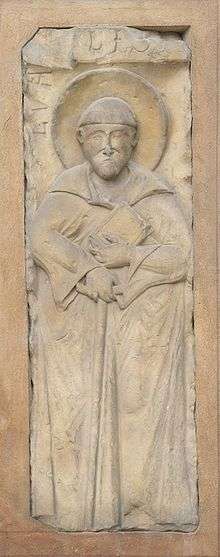Gunther of Bohemia

Gunther (c. 955 - 1045) was a Bohemian Catholic hermit and saint in the eleventh century.
Biography
Gunther was born in around 955 to a noble family, related to the Royal Otto Family as well as with the Hungarian Arpades.[1] He was a Duke of Thuringia, and is numbered among the ancestors of the princely house of Schwarzburg. He spent the early part of his life at court in the midst of worldly pleasures and ambitious intrigues.[2]
He was converted in 1005 at the age of fifty by St. Gotthard, Abbot of Hersfeld, later Bishop of Hildesheim, and resolved to embrace the monastic life in order to do penance for his past faults. With the consent of his heirs, he bequeathed all his goods to the Abbey of Hersfeld, reserving the right to richly endow and maintain the monastery of Göllingen, the ownership of which he persisted in retaining despite all the efforts of St. Gotthard to prevent him. In 1006, the novice made a pilgrimage to Rome, and in the following year made his vows as lay brother in the monastery of Niederaltaich before the holy Abbot Gotthard.[2] Gunther helped to bring civilization to the region by clearing the forests and planting fields.[1]
Soon afterwards, Gunther urgently entreated to be allowed to govern his monastery of Göllingen, and St. Gotthard's remonstrances could not turn him aside from his purpose. Shortly after his elevation to the abbacy, the former lay brother fell ill, and as he could not agree with his monks, the affairs of the monastery were soon in a perilous condition. By his charitable counsels mingled with severe reprimands, St. Gotthard succeeded in dispelling the ambitious views of Gunther, who returned once more to his humble condition at Niederaltaich, and led an edifying life.[2]
In 1008, he withdrew to a wild, steep place near Lalling, to live as a hermit. In 1011, he penetrated farther north in the forest with several companions and settled at Rinchnach, where he built cells and a church of St. John Baptist. Here he lived for thirty-four years a life of the greatest poverty and mortification. The very water was measured out to the brothers, guests alone being free to use at as they would.
It is said that Gunther received the gift of infused knowledge and became a powerful preacher though deficient in ordinary ecclesiastical learning: he could probably neither read nor write.[3] Wolfher, his biographer, relates that he knew him intimately, and often heard his admirable sermons on his patron, St John the Baptist—sermons which drew tears from all who heard them.
Gunther paid many visits to his relative the King of Hungary, obtained from him large sums for the poor, and urged him to build a number of churches and monasteries. Mabillon has reproduced the deed of donation made by King Stephen on 6 June 1009. In 1029 Conrad II richly endowed the monastery of Rinchnach, and in 1040 Emperor Henry III affiliated it with Niederaltaich Abbey.
In his old age, Gunther was highly respected by the rulers of Germany, Bohemia, Hungary and Poland. This allowed him to successfully negotiate between the Bohemian and German factions in the conflict Duke Bretislaus I of Bohemia and the German king Henry III in 1040. Gunther was likely present at the German defeat in the Battle at Brůdek on 22/23 August 1040, and he was the leader of the delegation negotiating with Bretislaus at Chlumec in the aftermath of the battle.[4]
Gunther died at about the age of ninety in Hartmanice, Bohemia, on 9 October 1045, in the arms of Duke Bretislaus and of the Bishop of Prague. He was buried in Brevnov Monastery but his remains were destroyed by the Hussites in 1420.[3]
Legacy
St. Gunther's Way (the Gunthersteig) is a walking holiday route that runs from Kloster Niederalteich on the Danube via Rinchnach into Bohemia.[5] Departing from the Niederalteich Monastery on the Danube, the path goes deep into the Bavarian Forest and across the border to the Bohemian village of Dobrá Voda.[6]
The Capuchin Mor (Hungary) has a statue of Saint Gunther Anchoret statue on its tower.[7]
References
- 1 2 'St. Gunther", Niederalteich – Bavaria´s Gateway to the East
- 1 2 3 Besse, Jean. "Blessed Gunther." The Catholic Encyclopedia. Vol. 7. New York: Robert Appleton Company, 1910. 18 Apr. 2013
- 1 2 "Saint Gunther", Hungarian Saints"
- ↑ M. Perlbach, Die Kriege Heinrichs III. gegen Böhmen. 1039-1041 (1870), 450–452.
- ↑ Bavarian Walking Holidays
- ↑ Seven Day Hike on the Gunthersteig
- ↑ [://www.cometohungary.com/mor-capuchin-church.en.html "Capuchin-church Mor", Come to Hungary.com]